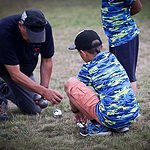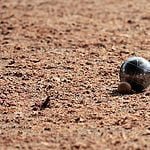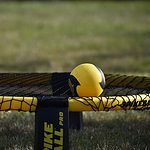Spikeball is a four-player volleyball-inspired game played on a net set up horizontally as a trampoline. The four players comprise two teams, each with two players who simultaneously bounce and volley the ball on a tight net back and forth. The idea behind Spikeball is to optimize the hits by one team, preventing the other team from volleying the ball. The game, which comprises a ball and a net, requires the ball to be properly inflated and the net correctly tightened. So, how tight should a spikeball net be?
What Is the Spikeball Setup?
Spikeball is centered on properly tightened and set up the net and appropriately inflated ball. The net serves as the goalpost as well as the center of the playground. These hula hoop-sized nets offer a large enough circumference for players to hoop around when playing the game.
A standard spike ball is rubber made and has a 12-inch circumference. These balls are air-filled and tightened, and imprinted just like small volleyballs. The balls must not be pumped with excessive air content, as that would make them hard to control during the play.
How Tight Should a Spikeball Net Be?
In achieving quality spikeball tightness, assemble the net correctly. Most spikeball net sets have removable plastic rims designed to fit seamlessly into five different legs. After you’ve assembled the rim, fasten the net into four different points inside the rim to easily tighten it. Confirm the net has been tightly secured for the ball to bounce off slickly.
Since the tightness level affects the play quality, you must tighten the ball properly, so it offers hard-hitting ball bounces. The most recommended net tension allows a ball dropped from 3-feet above to bounce not less than 12 inches in the air.
How to Build Your Spikeball Net?
Setting up the spikeball net would require a proper understanding of how every part of the net should be set. You wouldn’t enjoy going through an entire installation process only to find out later you did a shoddy job. Watch out for this three-step spikeball net setup guide for guidelines.
- Slip the rims smoothly into the leg sections. It’s an exercise as easy as grabbing one leg and inserting a rim and the next one until you’ve properly assembled the entire system correctly. Only move to the next step when you’re sure everything is correctly set up and working smoothly.
- Pre-attach the net. Now that you have a ready set up for attaching the net, hook the net’s four points to each of the four leg sections. The idea is to have the set installed with balanced tension.
- Tension your net correctly. The next step is to tighten the net so it can serve its intended role superbly well. Attach each of the net’s sections to the locks on the rims to create a stiff tension, ensuring the ball can bounce back and forth well during the play.
Factors Affecting the Tightness of a Spikeball Net
Multiple factors affect the tightness of a spikeball net and outlined here are those factors.
- Poorly set rims and frame. When building your spikeball, you must set the rims and frame correctly. If not, the net won’t hold tight and trying to make adjustments on the loose ends won’t work, either. Confirm with the user manual to know how the rims and framing should be installed for a tighter net setup.
- Poorly adjusted net setup. Another reason your spikeball net will probably not achieve the desired tightness is poor setup. Setup your spikeball net such that the ball will bounce no less than 12 inches high when you’ve dropped the ball 3 feet from the top.
- Substandard spikeball net. One complaint spikeball players give is of spikeball nets that don’t go past a certain limit during tightening. That often results in poorly setup nets that don’t give the quality of play they need to enjoy the game to the optimum. On that note, when buying a spikeball net, check the brand and manufacturer to be sure they are trustworthy. That’s the only way to have the assurance of getting quality nets that won’t resist adjustments.
Choosing Your Next Spikeball Set
Before judging your spikeball net’s tightness, don’t forget the spikeball set you choose will be a determining factor. So, if the net is not giving you the exact tightness you want, even after keenly following the user manual, know right away that the problem is the spikeball set you’ve. Don’t fall into such pitiable pitfalls because of making wrong purchase decisions. Watch out for this ultimate guide to selecting the best quality spikeball set:
- Construction materials: the spikeball quality is directly affected by the materials used and the workmanship. Look for a set with well-constructed legs, rims, and body as that would not just guarantee durability but also offer a strong resting place for the net. Choose a set with a strong and tight net that offers superior ball bouncing quality.
- Ball quality: the play quality is also directly affected by the quality of the ball. Look for high-quality spike balls that are textured, sized, and designed to offer superior bouncing power under different conditions. It should be designed so that, together with the right net, it will offer a smooth and enjoyable play.
- Look for a set with the right accessories: the best spikeball sets come with the right accessories and add-ons. Choose ones with essential accessories such as air pumps, rule books, additional gear, and video manuals. Be sure you’re paying for a set that comes with the right type and quality of a net.
How Tight Should a Spikeball Net Be – Conclusion
For you to understand the net tightness level needed for a spikeball game to be enjoyable, don’t underestimate the power of the right quality spikeball set. When you have a high-quality spikeball set, you’re sure the rims, net, framing, and everything else would be of excellent quality, and the gameplay would be amazing. Likewise, don’t underestimate the power of setting your spikeball net properly, following all the outlined guidelines as that, too affects the net’s tightness.





